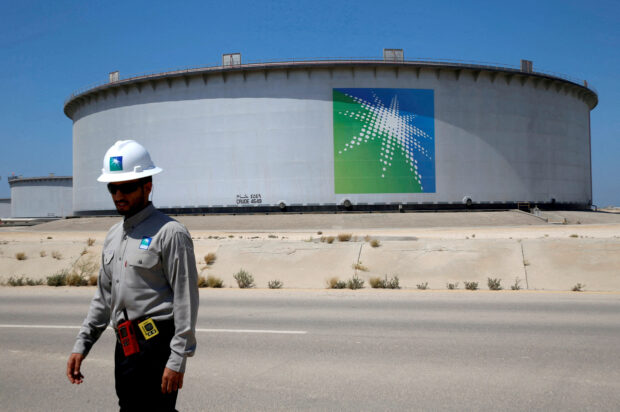FILE PHOTO: An Aramco employee walks near an oil tank at Saudi Aramco’s Ras Tanura oil refinery and oil terminal in Saudi Arabia May 21, 2018. REUTERS/Ahmed Jadallah/File Photo/File Photo
DUBAI – Saudi Arabia faces the risk of an economic contraction this year following its decision to extend crude production cuts, highlighting its still heavy reliance on oil as reforms to diversify are slow moving. Riyadh says it aims to stabilize the oil market by extending a voluntary oil output cut of 1 million barrels per day until the end of 2023. Its announcement on Tuesday sent oil prices above $90 for the first time this year, but they are below average prices of around $100 a barrel last year in the wake of Russia’s invasion of Ukraine.
Declining oil production and revenue this year could see Saudi Arabia’s economy shrink for the first time since 2020 at the height of the COVID-19 pandemic, although a hefty dividend from state oil producer Saudi Aramco should provide a cushion for public finances. Cutting oil output for another three months, on top of production cuts earlier in the year, translates into a 9-percent fall in production in 2023 – the biggest production drop in nearly 15 years for OPEC’s de facto leader – said analyst Justin Alexander at Khalij Economics.
Monica Malik, chief economist at Abu Dhabi Commercial Bank, now sees Saudi gross domestic product (GDP) contracting 0.5 percent this year, revising her forecast from last month of 0.2 percent growth this year, while Alexander said non-oil growth would need to average about 5 percent this year to maintain growth.
“This was actually precisely the growth rate in H1, but leading indicators such as the PMI (purchasing managers’ index) have pointed to a modest slowdown, so that might be hard to sustain in H2. As a result, a small real GDP contraction is looking likely,” Alexander, also Gulf analyst at GlobalSource Partners, said.
Last year the Saudi economy grew 8.7 percent and generated a fiscal surplus of 2.5 percent of GDP, its first surplus in nine years as oil soared to highs near $124. This year the government has forecast a surplus of 0.4 percent of GDP, but some economists say even that may be optimistic.
Saudi Aramco, 90 percent government-owned and awash with cash after last year’s boom, said last month it would fork out a near $10 billion dividend to shareholders in the third quarter from its free cash flow – the first of several extra payouts on top of its expected more than $150 billion base dividend for 2022 and 2023 combined.
“Even so, we think that the government will run a budget deficit of 1.5 percent of GDP this year – well below the Budget estimate for a 0.4-percent of GDP surplus,” James Swanston of Capital Economics said in a note. The Saudi finance ministry did not immediately respond to a request for comment. The kingdom’s deficit stood at 8.2 billion riyals ($2.19 billion) for the first half of this year.
An official from the International Monetary Fund, which had forecast a 1.2 percent of GDP deficit this year, said on Thursday the budget would be closer to balance as a result of the extra Aramco payout and, unlike a growing number of economists, the IMF also believes the economy will manage slight growth this year.
Growth in the non-oil economy remains strong for now. The Public Investment Fund (PIF), the sovereign wealth fund tasked with driving Saudi Arabia’s ambitious Vision 2030 economic blueprint, has spent billions on top global soccer stars, golf, tourism and entertainment, and electric vehicle makers.
“Certainly, we see no signs that the Public Investment Fund’s acquisition streak is cooling,” RBC Capital Markets said in a note. PIF did not immediately respond to a request for comment.
Still, reforms and state-led investment have seen the share of the non-oil sector’s contribution to GDP rise to 44 percent of GDP last year, up just 0.7 percentage point from 2016.
“I think the reality has sunk in that the pace of change cannot move as quickly as had been hoped and the economy remains dependent upon hydrocarbons and will do so for some time,” said Neil Quilliam, associate fellow at Chatham House in London.
Up to $50 billion worth of fresh Aramco shares could be offered on the Riyadh bourse before the end of the year, according to reports, generating vast funds that could be spent on big projects. The government has transferred 8% of Aramco to PIF and one of its subsidiaries. PIF’s funding comes from capital injections and asset transfers from the government, debt and earnings from investments. However, it reported a loss of $15.6 billion last year, mainly due to its SoftBank Vision Fund I investment and a wider market downturn, especially in tech.
“So far PIF investments haven’t proven to be as fruitful as had been hoped and neither has the country attracted the FDI (foreign direct investment) it had hoped either… So Aramco is going to be the horse that they keep on beating,” Quilliam said.
Denial of responsibility! Vigour Times is an automatic aggregator of Global media. In each content, the hyperlink to the primary source is specified. All trademarks belong to their rightful owners, and all materials to their authors. For any complaint, please reach us at – [email protected]. We will take necessary action within 24 hours.


